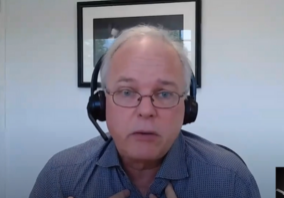Kevin Coldiron is a lecturer in the Masters of Financial Engineering Program at the Haas School of B
Inflation in the Twenty-First Century: Unintended Consequences
To learn more about Epsilon Theory and be notified when we release new content sign up here. You’ll receive an email every week and your information will never be shared with anyone else.
Continue the discussion at the Epsilon Theory Forum
27 more replies
The Latest From Epsilon Theory
DISCLOSURES
This commentary is being provided to you as general information only and should not be taken as investment advice. The opinions expressed in these materials represent the personal views of the author(s). It is not investment research or a research recommendation, as it does not constitute substantive research or analysis. Any action that you take as a result of information contained in this document is ultimately your responsibility. Epsilon Theory will not accept liability for any loss or damage, including without limitation to any loss of profit, which may arise directly or indirectly from use of or reliance on such information. Consult your investment advisor before making any investment decisions. It must be noted, that no one can accurately predict the future of the market with certainty or guarantee future investment performance. Past performance is not a guarantee of future results. Statements in this communication are forward-looking statements. The forward-looking statements and other views expressed herein are as of the date of this publication. Actual future results or occurrences may differ significantly from those anticipated in any forward-looking statements, and there is no guarantee that any predictions will come to pass. The views expressed herein are subject to change at any time, due to numerous market and other factors. Epsilon Theory disclaims any obligation to update publicly or revise any forward-looking statements or views expressed herein. This information is neither an offer to sell nor a solicitation of any offer to buy any securities. This commentary has been prepared without regard to the individual financial circumstances and objectives of persons who receive it. Epsilon Theory recommends that investors independently evaluate particular investments and strategies, and encourages investors to seek the advice of a financial advisor. The appropriateness of a particular investment or strategy will depend on an investor’s individual circumstances and objectives.
This commentary is being provided to you as general information only and should not be taken as investment advice. The opinions expressed in these materials represent the personal views of the author(s). It is not investment research or a research recommendation, as it does not constitute substantive research or analysis. Any action that you take as a result of information contained in this document is ultimately your responsibility. Epsilon Theory will not accept liability for any loss or damage, including without limitation to any loss of profit, which may arise directly or indirectly from use of or reliance on such information. Consult your investment advisor before making any investment decisions. It must be noted, that no one can accurately predict the future of the market with certainty or guarantee future investment performance. Past performance is not a guarantee of future results. Statements in this communication are forward-looking statements. The forward-looking statements and other views expressed herein are as of the date of this publication. Actual future results or occurrences may differ significantly from those anticipated in any forward-looking statements, and there is no guarantee that any predictions will come to pass. The views expressed herein are subject to change at any time, due to numerous market and other factors. Epsilon Theory disclaims any obligation to update publicly or revise any forward-looking statements or views expressed herein. This information is neither an offer to sell nor a solicitation of any offer to buy any securities. This commentary has been prepared without regard to the individual financial circumstances and objectives of persons who receive it. Epsilon Theory recommends that investors independently evaluate particular investments and strategies, and encourages investors to seek the advice of a financial advisor. The appropriateness of a particular investment or strategy will depend on an investor’s individual circumstances and objectives.










Thank you Kevin.
The most concise and clearly written explaination of the current problem facing central banks and investors I have read to date.
Looking forward to your follow up.
I’m staying tuned - looking forward to the next segment w/ great anticipation!
thanks!
I really like the note, like others have said it is clear and concise about a topic that lends itself to completely different adjectives. Which is always great.
But, (and given the credentials of the man writing this and , really, everyone here on this forum…I am starting to doubt myself a little), how can there be a 21st century diagram of the opposing inflationary/deflationary forces on either end of the “unstable equilibrium”, that does not list “technology/innovation” as a source of deflation? Does this not firmly belong alongside globalisation and demographics?
And if not, is the argument being made that technological innovation at this point in history has no (!) impact on inflation or simply that the inherent difficulties in measuring the direct impact of this disqualifies it from the diagram?
I understand that it complicates the picture that technology does not advance on a linear scale, that progress tends to happen in a step-change manner which means that there will be periods in time where there is very little impact on inflation one way or another - but this diagram is supposed to reflect 1980 to 2021! Are we saying that technological innovation during this period has had no bearing on inflation?!
The Federal Reserves itself, which perhaps for obvious reasons, has not paid too much attention to the disrupting tendencies of technological innovation started to organise a conference series in 2019 and even the description of the conference succinctly summaries the disinflationary impact of technology:
I am genuinely puzzled by this. It feels like anyone would need a solid reason to completely leave it out of a diagram attempting to portray the opposing forces at play and measurement bias is in my opinion that reason enough.
What I am missing?
Hi Em, Friedman said something like “inflation is always and everywhere a monetary phenomenon”. In the idealist monetarist controlled economy, prices are stabilised by policy. The implication is that the equilibrium is an administrative choice.
Yes, I am aware of Friedman’s quote. And of course, as a monetary economist he would prefer to define inflation as a purely monetary phenomenon. In the strictest sense, I will even agree that in the sense that inflation is defined as prices going up - then yes it is a monetary phenomenon.
But in the diagram in the article we are talking about, other distinctly non-monetary phenomenons are referenced, under the heading of “Structural”. “Demographics” is not a monetary phenomenon after all., so technological innovation would in my opinion belong under this heading in order to accurately reflect the pull and push between monetary and structural forces.
The equilibrium may well be an administrative choice, to me the interesting question is whether the administration process is accurately taking into consideration all relevant structural forces, if technological innovation is not considered.
1984
2023
Technology probably has had a disinflationary effect on food prices.
There is absolutely no doubt about that being true. Harvesting technology is only one of so many examples - crop biotechnology, pesticide/herbicide development, advances in processing/freezing/preserving/packing technologies, cold chain infrastructure that reduces spoilage and preserves food product integrity, etc,
Which is partially why I find it strange to have a conversation about whether or not inflation will come down or go up from where we are today, without bringing technology into the equation.
Maybe the answer is that it will not (at least not in this decade) change anything, but can we (or should we?) have the discussion without including it?
The impact of technology on productivity, including technologies impacting the utilization of agricultural and marine resources to produce various products including food products for humans and animals, ingredients for food products, or health and beauty aid/personal care products, etc. is constant, but may be more perceptible to casual observers when it happens in bursts. But it is always present and active, i.e, there is never a time when technology/innovation isn’t contributing to productivity gains, therefore counteracting price inflation (or bearing a deflationary effect).
However, I think that including the effect of technological advancements in the discussion about price inflation would confound the issue more than elucidate. This view hinges on the belief that the most valuable technology/innovation would occur whether or not the efforts to develop it are supported by government spending, and that pure capitalist motives are sufficient to spur the financial and operational investments needed for technology to advance. It’s therefore a view that’s difficult to maintain and defend amid so much evidence that taxation policy, and fiscal/trade policy do have a considerable effect on R&D investment.
Imo, this is an inextricably complicated problem specifically because of the level of wealth and power concentration we have in the world today and the ability of that concentrated power to impact all forms of policy (fiscal, monetary, trade, taxation, you name it) makes it almost hopeless to believe that policies will focus on boosting real economic growth through productivity gains, as opposed to being guided by corruption and things that are essentially legal fraud. The worst part about this is that the poorest and most vulnerable are very often the strongest supporters of policies and systems that deprive them of opportunities and/or work against their current interests because they are naive enough to believe the stories they are told by the establishment.
All that to say: if we include technology and government spending in the discussion about causing inflation to go up or down, then we should include the reality that these are influenced by a captured set of institutions, legislative and governance frameworks. Denying the latter part would be disingenuous toward the discussion topic, imo.
Edit: I think Friedman’s position probably assumed that governments and regulators always become captured and corrupted, and I think it’s impossible realistically to deny that this has occurred in our modern society, and this should be factored into any discussion that looks for non-monetary elements affecting inflation, particularly if those are often supported by government spending.
Thanks James, I very much appreciate that.